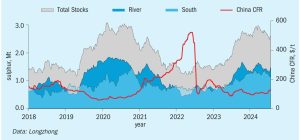
Fertilizer Latino Americano 2025
More than 1,100 attendees gathered in Rio de Janeiro, 26-29 January, for the 2025 Fertilizer Latino Americano (FLA) conference.

More than 1,100 attendees gathered in Rio de Janeiro, 26-29 January, for the 2025 Fertilizer Latino Americano (FLA) conference.

The start of a new year is a traditional time to take stock of the previous 12 months and look ahead to the next. In this regard, CRU’s most recent annual client survey, conducted at the end of December last year, makes interesting reading as to your own concerns for 2025 and beyond. There were numerous responses across commodity and financial sectors, and broadly based worldwide, if slightly skewed towards Europe and North America, but across all of these the key worry for the coming year clearly emerged as trade tariffs and protectionism. This is perhaps unsurprising, given incoming US president Donald Trump’s avowed intent to impose blanket 20% tariffs on all goods entering the US, and up to 60% on China. While most clients did not think tariffs would rise as much as some of Trump’s rhetoric might suggest, most expect rises of 5-10% across the board, and Asian businesses are most concerned. CRU’s most recent position paper on US tariffs highlights some of the internal political and legal challenges in implementing these, but does acknowledge that some rises will be inevitable, and may well produce the kind of reciprocal measures last seen in the previous Trump administration’s trade war with China and the EU in 2018.

Expensive feedstock, overseas competition and tightening environmental regulations all pose potential threats to Europe’s nitrogen industry.

As a tumultuous 2024 draws to a close, CRU’s fertilizer team to make a few predictions for the year ahead.

12 Dec 2024 On 8 December, Syrian rebel forces led by Islamist group Hayat Tahrir al-Sham (HTS) ousted the government of Bashar al-Assad. The now thirteen-year long civil war in the Middle Eastern nation has proven hugely disruptive to its phosphate rock production. During the 2020s exports recovered strongly amid Russian intervention and a lull […]

China’s acid production continues to grow as new smelters come on-stream. But high domestic demand from phosphate production as export restrictions are lifted and a shortage of copper concentrate may limit the potential for acid exports.
Join us at the CRU Sulphur + Sulphuric Acid 2024 Conference and Exhibition in Barcelona, 4-6 November, for a global gathering of the sulphur and sulphuric acid community. Meet leading market and technology experts and producers, network, share knowledge, and learn about market trends and the latest developments in operations, process technology and equipment.

At the end of August, the Qatar Chemical and Petrochemical Marketing and Distribution Company (Muntajat) tendered for 35,000 tonnes of sulphur for September loading from Ras Laffan, with offer prices reported at or around $130s/t f.o.b., according to market sources. Bids were received at multiple levels, with market participants initially anticipating awards around the mid-$120s/t f.o.b. The tender result was higher than market expectations and would equate to delivered prices to key Asian markets at $150-155/t c.fr. But prices in China and Indonesia remained lower this week at around $140-145/t c.fr, with India at $145-150/t c.fr. Prices have increased steeply since Muntajat’s 25 June session, which was indicated awarded in the mid-$80s/t f.o.b.. and Muntajat posted its Qatar Sulphur Price (QSP) for September at $125/t f.o.b., up $19/t from $106/t f.o.b. in August. This represents the highest QSP since March 2023 at $133/t f.o.b., and reflects delivered levels to China nearing $150/t c.fr at current freight rates. Tight supply and strong downstream demand have pushed tender prices higher. Muntajat tenders were previously awarded at $92/t f.o.b. in April, up from $88/t in March and the low $80s/t f.o.b. in February.

In the last two years there have been significant changes to the level and location of sulphur inventory, which has caused swings in short-term supply availability. Inventory plays a necessary role in balancing the sulphur market but exactly when, where, how, and why inventory enters the market can trigger a diverse range of price responses. In this insight article, CRU’s Peter Harrisson looks at how inventory change influences sulphur availability and pricing.

This year will be the 40th Sulphur – now Sulphur + Sulphuric Acid – Conference to be held. From its beginnings in Canada to this year’s meeting at the Hyatt Regency hotel in Barcelona, much has changed, but its mission – to be an essential annual forum for the global sulphur and acid community – remains the same.